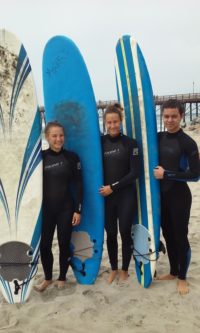Best Beginner Surf Boards
The right Beginner surf boards can make a big difference in the speed of progress for new surfers and the enjoyment they experience.
The Right Size is First

The films make surfing look easy and if you watch surfers at the beach, a lot of boys are tempted to just rent a wet suit and surfboard and head for the water. What all beginners learn, is it is not easy. The surfboard is designed to be streamlined and perform well in waves. It is very sensitive to where you place your weight. This is the issue beginners don’t know how to address.
The beginner surfer should start in foam waves and ride straight to the beach. The board needs to be balanced by the surfer to catch a wave, then wait until the board is in front of the wave, and then place hands on the board and pop up to perfect position.
The problem is, beginners aren’t perfect about anything at the beginning. They have a lot of bad inclinations that the surfboard won’t support. I used to train beginners on an 8′ foam board and then moved to 9′ foot with more success. Even on a 9′ foam surfboard, most surfers struggle at the beginning.
If the board is not big enough, then they don’t have the opportunity to progress from catching a wave to trying to stand up. I can coach new students through their errors until they are perfecting the techniques and riding the board to the beach. A 10′ board would be easier, but too big allows students to be sloppy and not really learn the techniques correctly.
Once students have learned the techniques and can land on the board correctly, I move my students to the 8′ foam surf board.
Progressing from Being a Beginner
Beginner surf boards should start with the foam board and then progress shorter 6″ at a time. The first good hardboard would be the fun board at 7’6″ in length, 21+” in width and at least 2 3/4 inches thick. Students could decide to stay with the long boards if they don’t surf often, if they are not real fit, or if they are older. Nothing wrong with surfing on 9′ hard boards. The line ups are full of them.
The shorter boards are harder to paddle, harder to catch waves, and harder to ride. Surfing progresses slowly. Improved surfing requires great flexibility (yes stretching), upper body strength (gym is good), stamina (aerobic cross training) and lots of courage. Shorter boards have to catch waves as they arc and therefore crashes are like being in a washing machine. As waves get bigger, crashes get your attention.
Have patience in your learning and stay on high volume boards to ensure that it is always fun. Too many crashes and the fun seeps out.
*
For surf lessons in Oceanside, see the Home Page
My pop up video
Good video for Catching Waves